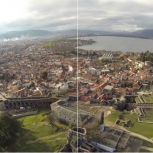
Ioannina
The city presents a significant cultural and educational activity. Offices, shops, museums, athletic facilities and coffee shops keep the city center live and vivid all time long.
The Municipality of Ioannina constitutes the traditional dynamic urban centre of the Region of Epirus and the main urban center of Western Greece, after Patras. With a population of approximately 112.486 inhabitants the Municipality of Ioannina is one of the 10 largest Municipalities, in terms of inhabitants, in Greece.
Located at the north-west of the Greek Peninsula it is found at the cross-‐border area between Albania and Greece. Geographically, the Municipality of Ioannina is found in the internal area of the European Union and specifically at the cross-‐border region between Greece and Italy. Strategically, the M. of Ioannina forms a geopolitical crossroad of the development axis of north Greece, especially after the construction of the Egnatia Odos Motorway. Combined with the Ionian Odos Motorway and the E65 motorway, Ioannina is a strategic Interchange Node of combined transportation due to its proximity to the country's international gateway, the port of Igoumenitsa.
The city's modern development is marked by its advancement in arts, literature, trade and tourism and is supported by the development of the regional infrastructure including Ioannina National Airport (King Pyrrhus), the Water Sports Center, the motorways and the city’s hospitals. The University of Ioannina, with its extensive research and technological activity, and the Technological Institute of Education (Τ.Ε.Ι.) of Epirus, also help the rate of progress and development of the city.
The Regional Unit of Ioannina produces 56,5% of the total GDP of the Region of Epirus. For 2009, GDP per capita, for the regional Unit of Ioannina, was at a level of 79% compared to that of the average EU 27 (Eurostat 2009). For the Municipality of Ioannina, out of the total Economically Active Population 42.781 persons declared “employed” and 8.231 persons declared “unemployed” (Greek Statistic Agency, 2011).
Although, one of the smallest and poorest of the Greek regions, Epirus has a potential to develop a specialised regional development strategy. Infrastructure investments (Egnatia road, Ionia road, Igoumenitsa port, etc.) over the last decade have better connected the region both nationally and internationally. Epirus is also home to a number of food and natural resource based businesses and the growth potential of alternative tourism (eco-‐tourism, etc.) is recognised. Moreover, regional scientific specialisation is more in line with regional needs than in some other Greek regions, with a number of specialised centres (notably in agro-‐food technology).
SOME RELATED NETWORKS
RESILIENT EUROPE
News



